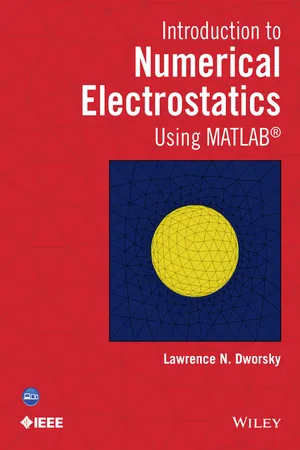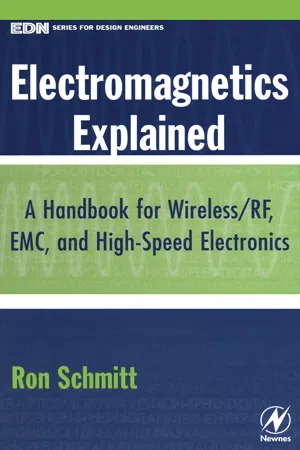Physics
Electric Field of Multiple Point Charges
The electric field of multiple point charges is the combined effect of the individual electric fields produced by each charge. It is determined by vector addition of the electric fields due to each charge at a given point in space. The resulting electric field at that point is the vector sum of the individual electric fields.
Written by Perlego with AI-assistance
Related key terms
Related key terms
1 of 4
Related key terms
1 of 3
11 Key excerpts on "Electric Field of Multiple Point Charges"
- Nima Gharib, Javad Farrokhi Derakhshandeh, Peter Radziszewski(Authors)
- 2022(Publication Date)
- Elsevier(Publisher)
Coulomb's law and electric field 3.1. Coulomb's law The basic electromagnetic concepts are studied one by one in sequence. A dimensional description will suffice in the vast majority of cases; the latter will be deduced from their relationship via the theory's basic equations, which will be tested experimentally. The next section will take place immediately after the current enumeration of essential concepts. To understand how much force does a single point charge q exert on a test charge Q while it is at rest r distance away, Coulomb's law can evaluate the answer as follows: (3.1) The constant ε 0 = (8.85 × 10 − 12 C 2 /N m 2) is referred to as open space permittivity (ludicrously). In SI units, newton (N) denotes force, meter (m) denotes distance, and coulomb denotes charge (C). In other words, the force is proportional to the charge product and inversely proportional to the square of the separation distance. Here, item Δ r is the separation vector with magnitude of r. The force is directed down the line q-Q ; it is repulsive if q and Q have the same sign, and attractive if they have the opposite sign. Coulomb's law and the principle of superposition provide the physical basis for electrostatics; all else is mathematical development of these basic laws, with the exception of a few specific features and elaboration these rules. 3.2. The electric field If there are many point charges, such as q 1, q 2, …, q n at distances r 1, r 2, …, r n from Q, the total force on Q is then equal to (3.2) or (3.3) Here, (3.4) Factor E (r) is referred to as the source of electric field charge, which is a function of position (r), since the separation vectors r i are location-dependent. However, it makes no mention of the test charge Q. The electric field is a vector quantity that varies across points and is governed by the arrangement of source charges as shown in Fig. 3.1 ; physically, E (r) is the force per unit charge that would be exerted on a test charge if placed at P. 4- eBook - ePub
- Michael M. Mansfield, Colm O'Sullivan(Authors)
- 2020(Publication Date)
- Wiley(Publisher)
The net electric flux density or electric field strength at any point is the vector sum of the contributions from each point charge (a so‐called Principle of Superposition), that is Figure 16.15 The net electric field strength at P due to a number of point charges is the vector sum of the individual contributions from each point charge. and that is, (16.7) Readers may have noticed that, although we have derived Equations (16.4) – (16.6) and subsequent relationships above from first principles, we did not strictly have to do so. The treatment involved is formally identical to the analysis of similar situations in the case of gravitation (Chapter 5). All relationships derived for point masses, with no loss of rigour, can be converted to the corresponding relationships for point charges by using the following transformations Note, however, that charge can take both positive and negative values while mass can only be positive. Continuous charge distribution The same idea can be used for a continuous distribution of charge where the charge can be broken up into a very large number of infinitesimal elements, such as the element of volume illustrated in Figure 16.16 (a). The electric charge density at a point r is defined as Figure 16.16 (a) The net electric field strength at P due to a continuous distribution of charge is the integral of the individual contributions from each volume element of charge - eBook - ePub
- A. L. Stanford, J. M. Tanner(Authors)
- 2014(Publication Date)
- Academic Press(Publisher)
vectorially . Mathematically we may writeE =(12-4)E 1+E 2+ … +E n=∑i = lnE i(12-4)whereE iis the field at P produced by the chargeQi.The relationship between the electric field E at a field point produced by point charges and the force on a test charge q placed at that field point is graphically demonstrated in Figure 12.1 In Figure 12.1(a) a positive test charge q is located a distance r 1 from a positive charge Q 1 and a distance r 2 from a negative charge –Q 2 . The forces F 1 and F 2 that the charges Q 1 and –Q 2 exert on q are indicated in their appropriate directions. These forces may be calculated from Equation (12–1) . According to the principle of superposition, the net force on q is F , the vector sum of F 1 and F2 . Figure 12.1(b) shows the same arrangement of Q 1 and –Q 2 but with q removed. At the point P , where q had been located, the electric field E is the vector sum of E 1 and E 2 , the fields produced by Q 1 and –Q 2 , respectively. Notice that the direction of E is the same as that of F in Figure 12.1(a) . Further, the magnitude of E is, according to Equation (12–2) , equal to F/q . Thus, if F has been determined to be the force exerted on a charge q by a point charge distribution, it becomes trivial to determine E: It is only necessary to divide F by q - Lawrence N. Dworsky(Author)
- 2014(Publication Date)
- Wiley-IEEE Press(Publisher)
q is therefore(1.2 )where is the unit vector along the line from charge q to point p and r is the distance from charge q to point p. The values of are expressed in volts per meter (V/m).Since the test charge at p in the preceding example doesn’t disturb the electric field, the electric field is considered to be a consequence of q; in other words, the test charge doesn’t have to be present for the field to exist.The term is a vector with both magnitude and direction. The direction of anywhere in space is identically the direction of the force that would be experienced by a (positive) test charge at that point. We can look at the field lines of as a representative of the direction of the force on a test charge due to q. For a single-point charge, the field lines are simply radial lines pointing away from the charge. The lines point away because a positive test charge placed anywhere would feel a force pushing it away from the (source) charge. The magnitude of the field decreases with the square of the distance from the charge.For a collection of charges, the electric field at any point is the sum of the contributions of all of the charges in the collection. Figure 1.1 , for example, shows electric field lines in the X–Y plane for two point charges placed at (-1,0,0) and (+1,0,0). In part (a) the two charges are identical; in part (b) they are the same in magnitude but opposite in sign.Electric field lines for point charges at (-1,0,0) and (1,0,0).FIGURE 1.1In order to calculate directly we must keep track of the vector components of every charge contributing to it. Continuing with the example of Figure 1.1 , the simple MATLAB function charges.m shown here calculates the field anywhere in the X–Y plane. Calculation of the field components from the geometry is shown in the equations in this program. Setting q 2- Keith C Brown(Author)
- 2020(Publication Date)
- Royal Society of Chemistry(Publisher)
eqn (11.2) is in terms of a unit vector:where Q s represents the source charge.So far, our equations have presumed a collection of discrete point charges. For a continuous distribution of charge our summation sign simply becomes an integral:There are three general types of charge distributions, charge distributed along a line, charge distributed over an area and charge distributed through a volume. We then add the distribution expression into the integral. For example, for volume distribution we can write in differential terms:(11.3)where we use ρ (x, y, z ) to represent the (continuous) distribution of charge throughout the volume as a function of position. The integral becomes:(11.4)How do we picture the electric field? There are two ways. The first is to use essentially the same view as the force fields pictured in Chapter 4 using vectors to indicate the magnitude and direction of the field at any point in space. This is a rather clumsy way to show the field as it is difficult to show the field at many points in space; the vectors take up so much room in the picture. The second, more elegant way is to use field lines . These are lines whose tangent is in the direction of the field vector at that point in space. So, for a simple single positive charge the two pictures are shown in Figures 11.1a and 11.1b- eBook - ePub
Electromagnetics Explained
A Handbook for Wireless/ RF, EMC, and High-Speed Electronics
- Ron Schmitt(Author)
- 2002(Publication Date)
- Newnes(Publisher)
By convention, the electric field is always drawn from positive to negative. It follows that the force lines emanate from a positive charge and converge to a negative charge. Furthermore, the electric field is a normalized force, a force per charge. The normalization allows the field values to be specified independent of a second charge. In other words, the value of an electric field at any point in space specifies the force that would be felt if a unit of charge were to be placed there. (A unit charge has a value of 1 in the chosen system of units.)Electric field = Force field as “felt” by a unit chargeTo calculate the force felt by a charge with value, q, we just multiply the electric field by the charge,The magnitude of the electric field decreases as you move away from a charge, and increases as you get closer. To be specific, the magnitude of the electric field (and magnitude of the force) is proportional to the inverse of the distance squared. The electric field drops off rather quickly as the distance is increased. Mathematically this relation is expressed aswhere r is the distance from the source and q is the value of the source charge. Putting our two equations together gives us Coulomb’s law,whereq1andq2are the charge values and r is the distance that separates them. Electric fields are only one example of fields.OTHER TYPES OF FIELDS
Gravity is another field. The gravitational force is proportional to the product of the masses of the two objects involved and is always attractive. (There is no such thing as negative mass.) The gravitational field is much weaker than the electric field, so the gravitational force is only felt when the mass of one or both of the objects is very large. Therefore, our attraction to the earth is big, while our attraction to other objects like furniture is exceedingly small.Another example of a field is the stress field that occurs when elastic objects are stretched or compressed. For an example, refer to Figure 2.2 . Two balls are connected by a spring. When the spring is stretched, it will exert an attractive force on the balls and try to pull them together. When the spring is compressed, it will exert a repulsive force on the balls and try to push them apart. Now imagine that you stretch the spring and then quickly release the two balls. An oscillating motion occurs. The balls move close together, then far apart and continue back and forth. The motion does not continue forever though, because of friction. Through each cycle of oscillation, the balls lose some energy until they eventually stop moving completely. The causes of fiction are the air surrounding the balls and the internal friction of the spring. The energy lost to friction becomes heat in the air and spring. Before Einstein and his theory of relativity, most scientists thought that the electric field operated in a similar manner. During the 1800s, scientists postulated that there was a substance, called aether, which filled all of space. This aether served the purpose of the spring in the previous example. Electric fields were thought to be stresses in the aether. This theory seemed reasonable because it predicted the propagation of electromagnetic waves. The waves were just stress waves in the aether, similar to mechanical waves in springs. But Einstein showed that there was no aether. Empty space is just that—empty.* - David V. Guerra(Author)
- 2023(Publication Date)
- CRC Press(Publisher)
+ q. Given that each charged particle in a distribution of charged particles creates an electric field vector at all points in space around the charged particle, a distribution of charged particles also causes an electric field to exist in the region around that distribution. At any given point in space, the total electric field is the vector sum of all the individual contributions to the electric field, at that point in space, by all the charged particles making up the distribution. So, for example, the electric field between two lines of charges should look something like the E-field in Figure 5.18. FIGURE 5.18 Electric field of two lines of opposite charge. Looking at the solid dot in the middle of the field, it is obvious that if a positive charge that is small compared to the charges that make up the distribution is placed at that point, this positive “test” charge will be pushed down and to the left by the positive charge above it and pushed up and to the left by the positive charge below it in the distribution. The opposite will be the case for the negative charge to its left, which will pull the test charge to the left. Together, the positive and negative line of charges will cause positive charges in the region between the lines of charges to be pushed to the left. Near the top and bottom of the distributions, the field lines will curve up and down as demonstrated in Figure 5.18 in a way similar to the field lines in Figure 5.16, so it is important to use the middle of a line distribution of charge to get the most uniform field. 5.5 Electrostatics and Gravity An electric field characterizes how electric charge affects the region of space around it and a gravitational field characterizes how mass affects the region of space around it- eBook - ePub
- George E. Owen(Author)
- 2013(Publication Date)
- Dover Publications(Publisher)
2. THE ELECTRIC FIELD INTENSITYConsider a region of space which contains N point source charges qj . In general we must consider that the N source charges occupy certain positions of equilibrium. This equilibrium is the final result of the electrostatic forces between the source charges coupled with certain mechanical constraints which must be specified for each particular situation. For instance, in Chapter IV we will find that when charges are placed on the surface of a conductor they are constrained to remain on the surface. This situation can be represented as a geometric constraint.Our purpose is now to obtain a measurement of the net force field set up by the N point charges, at any point in space. To accomplish this we introduce a test point charge Qt and measure the force exerted on it by the N source charges.Caution Must be Observed!If the magnitude of the test charge Qt is too large we may obtain a measurable rearrangement of the source charges. In other words, the act of making the measurement tends to alter the initial situation we wish to measure. Our desire therefore is to introduce the test charge without influencing the positions of the source charges. This of course is impossible.There is a technique, however, which will allow us to gauge the original force field in the limit as the magnitude of the test charge approaches zero. A series of experiments can be performed with a continual decrease in magnitude of Qt . In the limit as Qt goes to zero we will obtain the magnitude and direction of the original force field of the N source charges.To illustrate this we show an example plot of the magnitude of the net force F t as a function of Qt . It is quite clear that when Qt approaches zero the force on Qt goes to-zero. On the other hand, the ratio of F t to Qt - No longer available |Learn more
- Robert A. Pelcovits, Joshua Farkas(Authors)
- 2023(Publication Date)
- Barrons Educational Services(Publisher)
d. Therefore,Again, we’ll leave the final crunching out of the derivative to you.Answer check 2: The answer is consistent with the following situations.1.As d approaches infinity, the electric field approaches zero (the point moves an infinite distance from the charge distribution).2.As d approaches zero, the charge distribution acts like an infinite charged sheet. (If you were at the point, you wouldn’t be able to see the edge of the charge distribution; the edges would be too far away to matter.) In this situation, the electric field approaches:In later chapters, we will see that this is indeed the equation for the electric field of an infinite sheet of charge. Note that we didn’t ask what happens at d = 0. As we will learn in the next chapter, because there is infinite volume charge density at that point, the field is discontinuous, so it’s not a good place to confirm our results.CHAPTER SUMMARYThe force between two electric charges that are motionless is given by Coulomb’s law. When more than two charges are present, the force on any one of them can be found using Coulomb’s law and the principle of superposition. The electric field is defined as the force per unit charge. Electric field lines provide a convenient way to visualize the electric field produced by a charge distribution. The electric potential is the electric potential energy per unit charge, and the voltage is the difference in potential between two points in space.Integral calculus is used to find the electric field or potential due to a continuous charge distribution. This method is based on Coulomb’s law and the principle of superposition. The charge distribution is divided into differential regions whose shapes reflect the symmetry of the distribution. The electric potential is easier to calculate because it is a scalar quantity. Once the potential is determined, the electric field can be found by differentiation. - eBook - ePub
Introduction to Electromagnetism
From Coulomb to Maxwell
- Martin J N Sibley(Author)
- 2021(Publication Date)
- CRC Press(Publisher)
E , defined asWe can now write Coulomb’s law asE =(2.6)D εor, more generally,F =q 2EF = q E(2.7)From this equation, we can see that the force is directly dependent on the electric field strength, also known as the electric field intensity. We should note that, as E is directly proportional to D , it is also a vector quantity.The field strength is an important parameter in that it introduces us to the idea of a force field. Figure 2.5a shows an isolated point charge at the centre of a Gaussian sphere. As this figure shows, electric flux, ψ , radiates outwards from the charge. Also shown are the electric flux density and electric field strength vectors.FIGURE 2.5 Flux, flux density and electric field strength in (a) a positive charge field and (b) a negative charge field.Let us now introduce a positive test charge of 1 C. This charge will experience a repulsive force acting in a radial direction – the direction of the E field. As this test charge is 1 C, the magnitude of the force will also be the magnitude of the E field. Thus, the lines of flux are also the lines of force emanating from the charge. A similar situation arises with a negative charge: Figure 2.5b . So, we can say that a force field surrounds each charge, and that the field is repulsive if the charges are alike, and attractive if the charges are dissimilar.Example 2.3Determine the flux density and electric field strength at a distance of 0.5 m from an isolated point charge of +10 μC. If an identical charge is placed at this point, determine the force it experiences. Assume that the charge is in air.Solution Let us place the point charge at the centre of a Gaussian sphere of radius 0.5 m. Now, from Gauss’ law the total flux through the sphere is equal to the enclosed charge, i.e., - eBook - ePub
Dielectrophoresis
Theory, Methodology and Biological Applications
- Ronald R. Pethig(Author)
- 2017(Publication Date)
- Wiley(Publisher)
This was used as a mathematical tool by Maxwell, to show that rather than representing fluid flow the lines of force show the direction of the vector field E at any point in space. The concept of a ‘line of electric force’ is thus replaced with the concept of an ‘electric field line’. An indication of the field magnitude is provided by the spacing of these lines. Where the field is strong the lines are bunched together and they are spaced far apart where the field is weak. For the case of a point positive charge, its field radiates out with spherical symmetry and from Equation (3.6) the magnitude and direction of the vector field E are given by: (3.9) where is the unit radial vector. The more general case of field lines produced by two or more charges in three-dimensional space is shown in Figure 3.8. The direction of the electric field vector at any point along a field line is given by the tangent at that point. Apart from the special case of a uniform electric field, the magnitude of the field varies from point to point along a field line. In general, therefore, a vector field E in three-dimensional space has components E x, E y, E z, along the orthogonal x -, y - and z -axes: (3.10) where î, ĵ, and are the unit vectors along the x -, y - and z -axes, respectively. The components E x, E y, and E z may exhibit gradients (i.e., each varying as a function of distance along the x -, y - and z -axes, respectively). This is important for us, because as given by Equation (1.5) of Chapter 1, and in Box 2.4 of Chapter 2, the dielectrophoretic force depends on the gradient of the electric field. This gradient is expressed mathematically as the vector ∇E (variously known as ‘grad’ E or ‘del’ E) where the symbol ∇ functions as a differential operator, such that: (3.11) Figure 3.8 Some of the field lines are drawn between a positive and negative charge. The direction of the electric field vector E at point (e.g., A or B) is given by the tangent to the field line at that point
Index pages curate the most relevant extracts from our library of academic textbooks. They’ve been created using an in-house natural language model (NLM), each adding context and meaning to key research topics.
Explore more topic indexes
Explore more topic indexes
1 of 6
Explore more topic indexes
1 of 4










